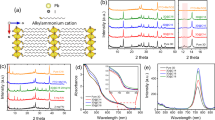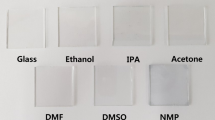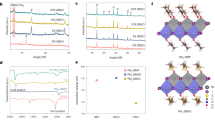Abstract
The fabrication of perovskite solar cells (PSCs) in ambient air can accelerate their industrialization. However, moisture induces severe decomposition of the perovskite layer, limiting the device efficiency. Here we show that sites near vacancy defects absorb water molecules and trigger the hydration of the perovskite, eventually leading to the degradation of the material. We demonstrate that guanabenz acetate salt eliminates both cation and anion vacancies, blocking the perovskite hydration and allowing the crystallization of a high-quality film in ambient air. With guanabenz acetate salt, we prepare PSCs in ambient air with a certified efficiency of 25.08%. The PSCs without encapsulation maintain around 96% of their initial efficiency after 2,000 hours of ageing in ambient air and after 500 hours of operating at the maximum power point under simulated air mass (AM) 1.5 G solar light in a N2 atmosphere. The encapsulated devices retained 85% of their initial efficiency after 300 hours under damp heat conditions (85 °C and 85% relative humidity).
This is a preview of subscription content, access via your institution
Access options
Access Nature and 54 other Nature Portfolio journals
Get Nature+, our best-value online-access subscription
$29.99 / 30 days
cancel any time
Subscribe to this journal
Receive 12 digital issues and online access to articles
$119.00 per year
only $9.92 per issue
Buy this article
- Purchase on Springer Link
- Instant access to full article PDF
Prices may be subject to local taxes which are calculated during checkout




Similar content being viewed by others
Data availability
All data generated or analysed during this study are included in the published article and its Supplementary Information. Additional data are available from the corresponding author on reasonable request. Source data are provided with this paper.
References
National Renewable Energy Laboratory Best Research-Cell Efficiency Chart (NREL, 2023); www.nrel.gov/pv/cell-efficiency.html
Zhao, Y. et al. Inactive (PbI2)2RbCl stabilizes perovskite films for efficient solar cells. Science 377, 531–534 (2022).
Bu, T. et al. Lead halide-templated crystallization of methylamine-free perovskite for efficient photovoltaic modules. Science 372, 1327–1332 (2021).
Hui, W. et al. Stabilizing black-phase formamidinium perovskite formation at room temperature and high humidity. Science 371, 1359–1364 (2021).
Li, N. et al. Liquid medium annealing for fabricating durable perovskite solar cells with improved reproducibility. Science 373, 561–567 (2021).
Lin, R. et al. All-perovskite tandem solar cells with improved grain surface passivation. Nature 603, 73–78 (2022).
Huang, H. et al. 24.8%-efficient planar perovskite solar cells via ligand-engineered TiO2 deposition. Joule 6, 2186–2202 (2022).
Li, X. et al. Constructing heterojunctions by surface sulfidation for efficient inverted perovskite solar cells. Science 375, 434–437 (2022).
Cui, P. et al. Planar p–n homojunction perovskite solar cells with efficiency exceeding 21.3%. Nat. Energy 4, 150–159 (2019).
Yang, X. et al. Perovskite hetero-bilayer for efficient charge-transport-layer-free solar cells. Joule 6, 1277–1289 (2022).
Wang, Y. et al. Stabilizing heterostructures of soft perovskite semiconductors. Science 365, 687–691 (2019).
Min, H. et al. Perovskite solar cells with atomically coherent interlayers on SnO2 electrodes. Nature 598, 444–450 (2021).
Yoo, J. et al. Efficient perovskite solar cells via improved carrier management. Nature 590, 587–593 (2021).
Jeong, J. et al. Pseudo-halide anion engineering for α-FAPbI3 perovskite solar cells. Nature 592, 381–385 (2021).
Caddeo, C. et al. Collective molecular mechanisms in the CH3NH3PbI3 dissolution by liquid water. ACS Nano 11, 9183–9190 (2017).
Cheng, S. & Zhong, H. What happens when halide perovskites meet with water? J. Phys. Chem. Lett. 13, 2281–229 (2022).
Tong, C. et al. Uncovering the veil of the degradation in perovskite CH3NH3PbI3 upon humidity exposure: a first-principles study. J. Phys. Chem. Lett. 6, 3289–3295 (2015).
Heo, S. et al. Origins of high performance and degradation in the mixed perovskite solar cells. Adv. Mater. 31, 1805438 (2019).
Raval, P. et al. Understanding instability in formamidinium lead halide perovskites: kinetics of transformative reactions at grain and subgrain boundaries. ACS Energy Lett. 7, 1534–1543 (2022).
Ho, K., Wei, M., Sargent, E. H. & Walker, G. C. Grain transformation and degradation mechanism of formamidinium and cesium lead iodide perovskite under humidity and light. ACS Energy Lett. 6, 934–940 (2021).
Wang, X. et al. Tailoring component interaction for air-processed efficient and stable all-inorganic perovskite photovoltaic. Angew. Chem. Int. Ed. 59, 13354–13361 (2020).
Xia, R. et al. An efficient approach to fabricate air-stable perovskite solar cells via addition of a self-polymerizing ionic liquid. Adv. Mater. 32, 2003801 (2020).
Wang, J. et al. Ambient air processed highly oriented perovskite solar cells with efficiency exceeding 23% via amorphous intermediate. Chem. Eng. J. 446, 136968 (2022).
Wang, M. et al. A universal strategy of intermolecular exchange to stabilize α-FAPbI3 and manage crystal orientation for high-performance humid-air-processed perovskite solar cells. Adv. Mater. 34, 2200041 (2022).
Wang, Z. et al. Achieving efficient and stable perovskite solar cells in ambient air through non-halide engineering. Adv. Energy Mater. 11, 21021 (2021).
Salim, K. M. M. et al. Boosting long-term stability of pure formamidinium perovskite solar cells by ambient air additive assisted fabrication. ACS Energy Lett. 6, 3511–3521 (2021).
Liu, Y. et al. Phase aggregation suppression of homogeneous perovskites processed in ambient condition toward efficient light-emitting diodes. Adv. Funct. Mater. 31, 2103399 (2021).
Jung, K. et al. Ambient-air fabrication of stable mixed cation perovskite planar solar cells with efficiencies exceeding 22% using a synergistic mixed antisolvent with complementary properties. Nano Energy 89, 106387 (2021).
Dai, X. et al. Efficient monolithic all-perovskite tandem solar modules with small cell-to-module derate. Nat. Energy 7, 923–931 (2022).
Wang, G. et al. Thermal radiation driven ultrafast crystallization of perovskite films under heavy humidity for efficient inverted solar cells. Adv. Mater. 34, 2205143 (2022).
Chao, L. et al. Direct and stable α-phase formation via ionic liquid solvation for formamidinium-based perovskite solar cell. Joule 6, 2203–2217 (2022).
Wang, Z. et al. Air-processed MAPbBr3 perovskite thin film with ultrastability and enhanced amplified spontaneous emission. Small 17, 2101107 (2017).
Saidaminov, M. et al. Suppression of atomic vacancies via incorporation of isovalent small ions to increase the stability of halide perovskite solar cells in ambient air. Nat. Energy 3, 648–654 (2018).
Aristidou, N. et al. Fast oxygen diffusion and iodide defects mediate oxygen-induced degradation of perovskite solar cells. Nat. Commun. 8, 15218 (2017).
Lee, J. W. et al. Rethinking the A cation in halide perovskites. Science 375, 835 (2022).
Tong, J. et al. Carrier lifetimes of >1 μs in Sn–Pb perovskites enable efficient all-perovskite tandem solar cells. Science 364, 475–479 (2019).
Yang, S. et al. Tailoring passivation molecular structures for extremely small open-circuit voltage loss in perovskite solar cells. J. Am. Chem. Soc. 141, 5781–5787 (2019).
Wang, R. et al. Constructive molecular configurations for surface-defect passivation of perovskite photovoltaics. Science 366, 1509–1513 (2019).
Yang, X. et al. Multiple-defect management for efficient perovskite photovoltaics. ACS Energy Lett. 6, 2404–2412 (2021).
Xue, J. et al. The surface of halide perovskites from nano to bulk. Nat. Rev. Mater. 5, 809–827 (2020).
Chen, S. et al. Atomic-scale imaging of CH3NH3PbI3 structure and its decomposition pathway. Nat. Commun. 12, 5516 (2021).
Jodlowski, A. et al. Large guanidinium cation mixed with methylammonium in lead iodide perovskites for 19% efficient solar cells. Nat. Energy 2, 972–979 (2017).
Liang, Y. et al. Lead leakage preventable fullerene-porphyrin dyad for efficient and stable perovskite solar cells. Adv. Funct. Mater. 32, 2110139 (2022).
Li, Z. et al. Organometallic-functionalized interfaces for highly efficient inverted perovskite solar cells. Science 376, 416–420 (2022).
Wei, D. et al. Ion-migration inhibition by the cation-π interaction in perovskite materials for efficient and stable perovskite solar cells. Adv. Mater. 30, 1707583 (2018).
Lin, D. et al. Ion migration accelerated reaction between oxygen and metal halide perovskites in light and its suppression by cesium incorporation. Adv. Energy Mater. 11, 2002552 (2021).
Li, W. et al. The critical role of composition-dependent intragrain planar defects in the performance of MA1–xFAxPbI3 perovskite solar cells. Nat. Energy 6, 624–632 (2021).
Wang, F. et al. Defects engineering for high-performance perovskite solar cells. npj Flexible Electron. 2, 22 (2018).
Khenkin, M. V. et al. Consensus statement for stability assessment and reporting for perovskite photovoltaics based on ISOS procedures. Nat. Energy 5, 35–49 (2020).
Mendez, P. F. et al. Analysis of the UV-ozone-treated SnO2 electron transporting layer in planar perovskite solar cells for high performance and reduced hysteresis. Sol. RRL 3, 1900191 (2019).
Kim, M. et al. Methylammonium chloride induces intermediate phase stabilization for efficient perovskite solar cells. Joule 3, 2179–2192 (2019).
Kresse, G. et al. Efficient iterative schemes for ab initio total-energy calculations using a plane-wave basis set. Phys. Rev. B 54, 11169–11186 (1996).
Kresse, G. et al. Efficiency of ab-initio total energy calculations for metals and semiconductors using a plane-wave basis set. Comput. Mater. Sci. 6, 15–50 (1996).
Perdew, J., Burke, K. & Ernzerhof, M. Generalized gradient approximation made simple. Phys. Rev. Lett. 77, 3865–3868 (1996).
Blöchl, P. E. et al. Projector augmented-wave method. Phys. Rev. B 50, 17953 (1994).
Kresse, G. et al. From ultrasoft pseudopotentials to the projector augmented-wave method. Phys. Rev. B 59, 1758 (1999).
Weller, M. T., Weber, O. J., Frost, J. M. & Walsh, A. Cubic perovskite structure of black formamidinium lead iodide, α‑[HC(NH2)2]PbI3, at 298 K. J. Phys. Chem. Lett. 6, 3209–3212 (2015).
Klimeš, J. et al. Van der Waals density functionals applied to solids. Phys. Rev. B 83, 195131 (2011).
Acknowledgements
This work is supported partially by National Natural Science Foundation of China (grant numbers 52232008, 51972110, 52102245 and 52072121), Beijing Natural Science Foundation (2222076, 2222077), project of State Key Laboratory of Alternate Electrical Power System with Renewable Energy Sources (LAPS202114), Huaneng Group Headquarters Science and Technology Project (HNKJ20-H88), the Fundamental Research Funds for the Central Universities (2020MS023, 2020MS028, 2023MS042) and the NCEPU ‘Double First-Class’ and sponsored by Beijing Nova Program. We thank H. Meng (National Institute of Metrology, China) for assistance with characterizing the performance of the device, C. Guo (Tsinghua University) and M. Chen (Peking University) for helping with the spectroscopy measurements. We also thank M. Wang, X. Ding and J. Chen (North China Electric Power University) for assisting with DFT calculation and discussion.
Author information
Authors and Affiliations
Contributions
M.L. and L.Y. conceived the idea. M.L. and P.C. guided the work as supervisors. L.Y., H.H. and P.C. did experimental designs, device fabrication and data analysis. Z.L., S.D., Y.Y. and S.Q. participated in the device fabrications and some material and device characterizations. X.W., B.L., Q.Z., Y.L and H.L. supported the measurement system construction, device fabrication, characterization and discussions. L.Y., H.H., P.C. and M.L. participated in manuscript writing and revising. X.Z., X.Y., J.J. and M.L. polished the manuscript language. All authors were involved in the discussions and approved the paper.
Corresponding author
Ethics declarations
Competing interests
The authors declare no competing interests.
Peer review
Peer review information
Nature Energy thanks Sofia Masi, Makhsud Saidaminov and the other, anonymous, reviewer(s) for their contribution to the peer review of this work.
Additional information
Publisher’s note Springer Nature remains neutral with regard to jurisdictional claims in published maps and institutional affiliations.
Supplementary information
Supplementary Information
Supplementary Figs. 1–31, Notes 1–8 and Tables 1–10.
Supplementary Data 1
The accelerated degradation measurements data of unencapsulated PSCs (Source Data for Supplementary Fig. 31).
Source data
Source Data Table 1
Statistical source data.
Source Data Table 2
Statistical source data.
Rights and permissions
Springer Nature or its licensor (e.g. a society or other partner) holds exclusive rights to this article under a publishing agreement with the author(s) or other rightsholder(s); author self-archiving of the accepted manuscript version of this article is solely governed by the terms of such publishing agreement and applicable law.
About this article
Cite this article
Yan, L., Huang, H., Cui, P. et al. Fabrication of perovskite solar cells in ambient air by blocking perovskite hydration with guanabenz acetate salt. Nat Energy 8, 1158–1167 (2023). https://doi.org/10.1038/s41560-023-01358-w
Received:
Accepted:
Published:
Issue Date:
DOI: https://doi.org/10.1038/s41560-023-01358-w



